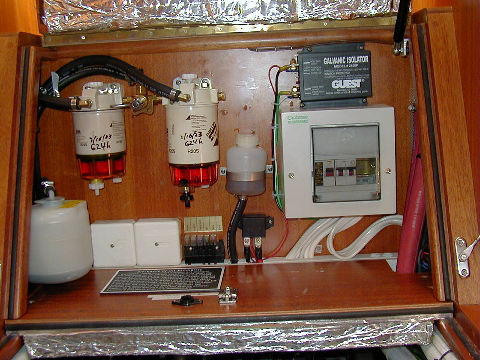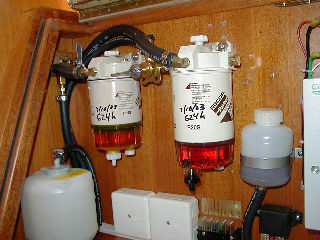Installing a Second Fuel Filter
A common reason for engine failure is dirty fuel. Normally, your fuel filter will protect the engine from dirt, but eventually it can clog up, depriving the engine of fuel. A common time for this to happen is just when you need the engine the most: in a heavy seaway when the waves churn up the tank, pumping sediment into the filter.
I decided to add a second filter so that if one gets clogged, the other can be brought into action quickly.

I really coveted a Racor dual filter such as the 75/500, but there isn't enough room under the companionway stairs to fit one. It would have to be mounted in the engine compartment where it would be very inconvenient to service. And, they are very expensive (about $700)!
I already had one spin-on Racor diesel filter, so I settled for adding a second spin-on, connecting them in parallel using 3-way valves. This was very inexpensive — just the cost of the extra filter, and two 3-way valves. Installing it was a bit more involved than I expected (as usual). I had to move nearly every piece of equipment under the companionway stairs to make enough room for the extra filter.

Now if a filter clogs up, all I have to do is turn two valves.
Replacing a filter is also easy. Each of the filters has a built-in priming pump. The process is to close the inlet and outlet valves of the filters, replace the filter, open up the filter's air vent, then prime until fuel flows out of the vent. Close the vent, open the inlet and outlet valves. Using this process, you don't get air in the stretch of fuel hose between filter and engine, so no other priming is needed.
But, if you do, the secondary fuel filter (located on the engine itself) on the Yanmar 4JH2 engines has yet another built in priming pump that can be used to clear the air.
The final bit of line is the injector feeds. Clearing this would require loosening the feed line at the injectors, but I've found the Yanmar to be very tolerant of air in this stretch. Just crank the engine a couple times and voila! it's gone.